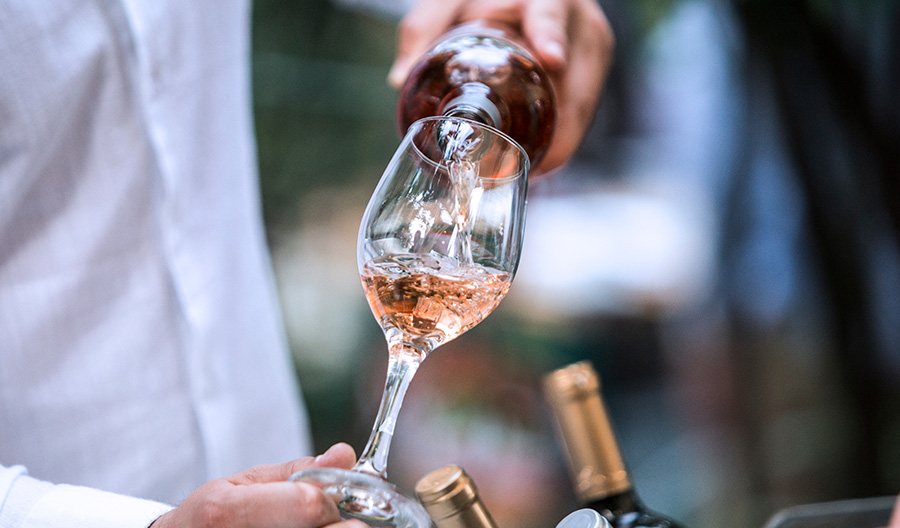Nothing is quite like a perfectly grilled steak and a glass of wine. However, when the two are paired, we tend to default to the old “red wine with red meat” rule. The thought is that only red wine has the richness and texture to stand up to a steak’s robust flavors. But there are alternatives that can transform your steak pairing experience.
More delicate than red wine yet bold in personality, rosé is one of wine’s most versatile performers. Often enjoyed during warmer months alongside lighter cuisine, many rosé lovers now savor it year-round with heartier dishes, including steak. Gaining its color from black and red grapes, rosé shares many characteristics with red wine. Its versatility rests in the robust varieties used, its place of origin, and expert blending.
With an array of pink hues, fruity notes, spicy finishes, zesty tannins, and degrees of richness, rosé can complement a steak well. Below, accomplished sommeliers and wine experts around the country offer up their favorite rosé and steak pairings. Here’s the breakdown, cut-by-cut.
New York Strip
Coming from the short loin of a steer, the New York strip is one of the most iconic cuts of steak. A deeper style rosé made from Cabernet Franc complements the savory, earthy and peppery flavors of this cut of steak. Loire Valley, one of France’s most diverse wine regions, produces exquisite rosés from the variety. Along with its red-berry aroma, Cabernet Franc is also known for its distinct herbal notes. Medium-bodied and light on the palate, it possesses the tannin strength to pair well with a strip steak.
Top Sirloin
Top sirloin is a cut that comes from the primal loin, or hindquarters, of the steer. Its low fat content, yet firm texture, makes for a flavorful, beefy steak. A rosé with good acid, solid body and a lot of personality is a top sirloin’s perfect match. Located in the southern region of Italy, Puglia is known for cultivating the Negroamaro grape, which produces bold, deep Italian red wines. Nicely structured, a Negroamaro rosé flaunts aromas of dark berries and licorice and has a spicy, tannic finish.

Flank Steak
The flank steak comes from the lower abdominal muscles. The cut is thinner, so it easily pairs with a Spanish Tempranillo or a Grenache rosé since these wines are bright and floral with nice fruit.
Known for its bold red fruit and spiciness, Tempranillo is a black grape grown primarily in the Rioja region in Spain. Tempranillo rosés are commonly blended with Garnacha (known in France as Grenache). Grenache is dominant in most Southern Rhône wines, especially in the revered Châteauneuf-du-Pape Appellation d’Origine Contrôlée (AOC). A Grenache rosé is fruit-forward, floral on the nose and tends to be lighter on the palate with low tannins.
Ribeye
Famous for its marbled fat that creates intense flavor, this steak is from the rib section, hence the name. It’s also one of the pricier beef options. Ribeye steak needs a rosé with tannin and constitution. A Tavel is recommended. The Grenache/Cinsault/Syrah/Mourvèdre blends from this AOC are known for their rich, firm bodies, deep, fat-cutting tannins and spicy red fruits.
The Tavel appellation is located in the Southern Rhône area of France. Said to be a favorite of Ernest Hemingway and King Louis XIV, it is one of the most renowned rosé appellations in Europe. Its bottlings are known for darker pink hues, earthy aromas and strong tannins.
Hanger Steak
Taken from the lower belly, the hanger steak is also a thinner cut, like flank. Hanger steak preparations tend to be bit lighter. It is important to consider the style of preparation when pairing. Think about the garlic and herbs a hanger steak can be prepared with. Go for a fruitier, watermelon-y or citrusy, less-tannic pink that’s more easy-going. A Provençal style, very light or salmon pink, is a terrific option.
In the Provence region of southeast France, rosé accounts for more than half of the wine produced. The grape varieties found typically in a Provençal rosé are Grenache, Cinsault, and Mourvèdre, usually blended. Provençal-style rosés are dry, have a higher acidity, lighter shades of pink, and more fruit-forward notes.
Prime Rib
Coming from the best parts of the rib section, this bone-in steak deserves an impeccable type of rosé—a rosé Champagne. Sparkling wines, especially Champagne, can stand up to red meat beautifully. Pairing a bubbly rosé Champagne works because of the acid and minerality in the wine, along with the delicious savory flavors, which work nicely with red and purple fruit notes and yeast flavors.

